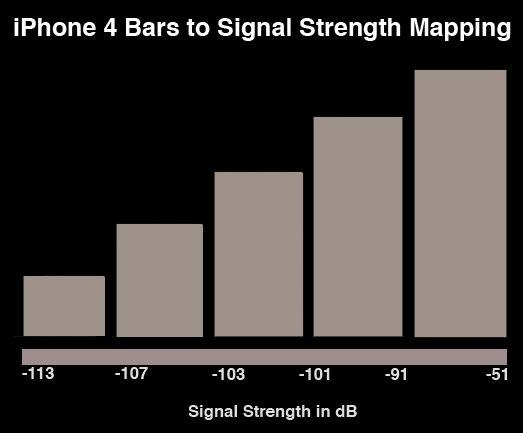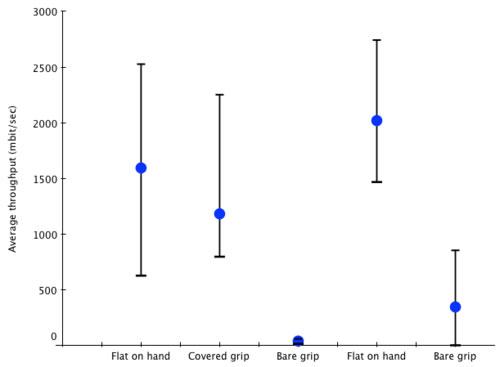Wireless experts weigh in on iPhone 4 reception issues
Anandtech: Antenna is improved, but bumper is needed
Authors Anand Lai Shimpi and Brian Klug did a barrage of tests on the iPhone 4, as compared to the iPhone 3GS and Google Nexus One. They found that the new model gets the best reception of any iPhone, holding on to one bar with voice and data for longer than its predecessor.
"With my bumper case on, I made it further into dead zones than ever before, and into marginal areas that would always drop calls without any problems at all. It's amazing really to experience the difference in sensitivity the iPhone 4 brings compared to the 3GS, and issues from holding the phone aside, reception is absolutely definitely improved."
But despite the improved antenna, the analysis found that reception could be significantly degraded depending on how users hold the phone. When cupping the phone tightly, the iPhone 4 had the worst signal attenuation of all devices with 24.6 dB, followed by the HTC Nexus one at 17.7 dB and last year's iPhone 3GS at 14.3 dB. When holding naturally, the story remained the same: The iPhone 4 was worst with a highest attenuation of 19.8 dB, followed by the Nexus one at 10.7 dB and the iPhone 3GS at 1.9 dB.
Though the maximum impact on reception from holding the iPhone in the lower left corner is 24 dB, the effect it has on reception and bars depends largely upon how the iPhone reports signal strength. Apple's iOS allots nearly 40 percent of reception levels to five bars, from -51 dB to -91 dB. But the distance from four bars to one bar of reception is much less, from -91 dB to -113 dB.
"In locales that have less signal, but where iOS still displays 5 bars, the drop of 24 dB is visualized much differently," they wrote. "For example, at another test location, signal without holding the phone is -89 dB, which is still displayed as 5 bars. Cup the phone, and you'll fall all the way to -113dB. All the bars dramatically disappear one after the other, people think they've dramatically lost all the signal, and you know the rest."
Apple publicly commented on the antenna issues last week, stating that any mobile phone will lose some reception when held in the hand, depending on the placement of the antennas. The company advised customers to avoid gripping the device in the lower left corner, or use one of many available cases, including its own "bumpers" which cover the metal external antenna band.
Some have argued that Apple should give away free bumpers to alleviate the issue for customers, though the company has informed its AppleCare representatives that it is not "appeasing" anyone with a free case.
"At the end of the day, Apple should add an insulative coating to the stainless steel band, or subsidize bumper cases," Anandtech wrote. "It's that simple."
Ph.D weighs in: Fantastic device, lousy phone
Richard Gaywood, who has a Ph.D in wireless network planning techniques from Cardiff University, also explained how signal bars on a cell phone work. Calling it a "magic formula" that is "basically made up by the design engineers as they see fit," he said the signal bars themselves are "almost meaningless and should not be relied upon."
"The bars only indicate how well your phone can listen to the cell tower," he said. "They don't tell you anything about how well the tower can receive your phone, but that's a pretty important part of making a call. Similarly, the phone doesn't know anything about what's going on in the cell provider's network past the tower; if you're on a really busy cell it might not have any spare outgoing circuits to direct your call to, so even if the radio is working fine, you might still not be able to get through."
Gaywood tested the iPhone 4 in three manners: flat on his hand, held in a usual manner, and then held with a piece of cloth protecting his skin from the phone. Touching the point in the bottom left of the device where the cellular antenna meets the Wi-Fi, Bluetooth and GPS antenna can result in signal degradation or cause dropped calls, as a person's skin acts as a conductive agent bridging the two antennas.
The tests were conducted both in a "marginal" signal area, as well as a location where signal strength is strong. With marginal signal, holding the phone with one's bare hand had a significant effect on reception, dropping all the way down to EDGE speeds and at one point preventing the device from transferring data.
"This is a factor that doesn't apply to other modern cell phones, because other modern cell phones don't have electrically active components in contact with their bare skin," he wrote.
When Apple announced the iPhone 4 earlier this month, the company revealed that the metal band around the outside of the device has breaks in it to allow the multiple antennas inside the device — for cellular service, Wi-Fi, Bluetooth and more — to establish connections. The larger metal piece on the right side of the phone serves as the GSM/UMTS cellular antenna, and the smaller portion on the left side is responsible for Bluetooth, Wi-Fi and GPS.
Gaywood's tests also found a performance penalty for the iPhone 4 when held with a bare grip, although signal did not drop to the extent that he did not have a data connection as it did in the marginal reception area. The results suggest that customers in a strong signal area may never notice any issues with the iPhone 4. He also noted that the issues don't "feel like a software fault," suggesting Apple could not fix users' reception woes with an iOS update.
Finally, he concluded with a personal note: "I'd say that iPhone 4 is a fantastic device but a lousy phone."
 Sam Oliver
Sam Oliver













 Malcolm Owen
Malcolm Owen
 William Gallagher and Mike Wuerthele
William Gallagher and Mike Wuerthele
 Christine McKee
Christine McKee
 William Gallagher
William Gallagher

 Marko Zivkovic
Marko Zivkovic









